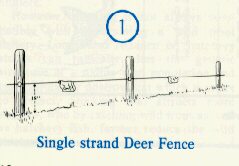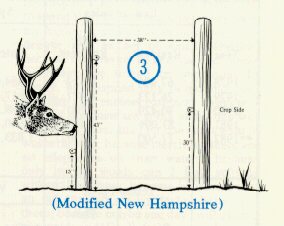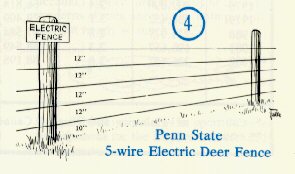
by: Ross Hall
MARCH 1983
The obvious retort of many frustrated gardeners reading the title of this article will be "Shoot the damn things". Admit it, however, despite the fact that they have again eaten this year's beans, down deep there is still an affection for deer. The purpose of this article is an attempt to help gardeners find a peaceful solution for saving their gardens from the nocturnal visits of deer.
Scare Devices
People have tried to scare deer in a great variety of ways. Each relates in some manner to a deer's sense of sight, hearing, smell or taste. Often they do not work or work only temporarily.
An important concept to understand is conditioning. Have you ever driven 100 km per hour on a highway and watched crows stand unconcerned at the roadside as you sped by? So accustomed or conditioned to the traffic have they become that they are no longer afraid. This explains why various scarecrow devices work only for a short time. Deer, like crows, overcome their fear for an unchanging object.
In using scare devices it is most important to change their positions often. Also, don't rely too much on one type; use a variety. Consider a red flannel shirt hung as a scarecrow on a post by a garden. Initially, perhaps, the shirt made the deer nervous. But if the shirt stays in the same place for seven days and emits no human odor, the deer will soon overcome any fear. Next time an even more elaborate device will be needed.
Another important strategy is to scare the animals as soon as they begin to come to a garden. The more visits a deer makes, the more at ease it becomes in the garden environment. In time it will develop a habit that is hard to break.
Some examples of scare devices follow. None are guaranteed to work. Success will depend on the deer's previous conditioning to garden feeding and on your effort.
First, there are the classic scarecrow structures that resemble human forms. I have seen simple, empty fertilizer bags inverted over stakes in gardens bring relief for a week or more. Anything odd balloons, streamers, aluminum pie plates will make the deer uneasy; remember to alter locations.
There are also a number of odor repellants. These are not taste repellants that one might spray on, for example, dormant apple trees. Rather foul smelling and supposedly frightening substances that are placed near gardens. Creosote or kerosene soaked rags or moth balls in perforated cans are examples. Their effect, like that of most scare devices, is only temporary. Some people claim that human hair collected from barber shops and hung in bags is effective. One researcher suggested the faeces and urine of tigers, lions or cougars - but no doubt you will have trouble obtaining this material. I once tried the bobcat lure that one can purchase from trapping suppliers. My results were inconclusive but neighbourhood dogs found the smell interesting.
The Maine Department of Fisheries has reported that jute rope soaked in undiluted Chaperone (a dog and cat repellant containing thiram) is effective. We have tried this idea to keep beaver away from culverts. It appears that there must be a large amount of rope or twine to prove effective. We have also experimented with tankage (a product of rendering companies) to repel deer. The results were mixed but mostly negative. Perhaps the results are better if the smelly tankage is used along with a scarecrow-type structure.
Dogs tied beside gardens is another suggestion. However, there are discouraging stories dogs sleeping as deer feed or of a dog tearing out rows of potatoes as it ran on the end of its leash.
Noise-producing devices might include a radio or a tape perhaps under a barrel placed in a garden. There are also commercial devices called Av-Alarm and gas exploders. These may be too expensive for the average home gardener. To prolong their effectiveness, noises should be played in an intermittent or a confusing manner.
Shots might be fired to frighten deer. For this action one should notify your local Lands and Forests office and your neighbours and keep safety in mind.
Attempting to solve the problem of deer in your garden can become as frustrating and, for some, as much an obsession as solving Rubic's Cube. Finding a cheap and an easy scare device that will bring a long-term solution is not easy. The Department would welcome any advice from an ingenious gardener who has the answer.
Fences
If you have given up with the scarecrow methods, it is now time to enter into a more expensive yet more effective phase.
The ultimate and long-term solution is a wire mesh fence at least 8 feet (2.4 M) high of hog wire fencing. The fence, of course, is costly. Possibly one could obtain the substitute, a discarded commercial ground fisherman's net. One advantage of the fence is that it can be used as a trellis.
Electric fences have been designed specifically to exclude deer. Although less expensive than a wire mesh barrier, they do require more maintenance
Electric fences do work. critics will say that deer can easily jump over an electric fence, yet it is more normal for a deer to walk to a garden and to try to crawl under any barrier. A deer's brain has no concept of electricity. Perhaps the deer relates the shock to a more recognized experience of disturbing a hornet's nest.
A very simple design, and a fence that I have seen work successfully around a small garden, consisted of a single wire suspended about 15 inches (38 cm) above the ground. The wire was attached with electrician's tape to short, reinforcing rod posts (one could use insulators and wooden stakes). An apple tree stood beside the garden and deer would eat the apples outside the fence but not inside.
The effectiveness of the single wire fence can be increased by the dirty trick of smearing peanut butter on the wire or on aluminum foil attached to the wire. This encouraged the deer to touch the wire with its wet tongue or nose, and so get a stronger jolt.
People with small gardens should experiment with this fence design first before proceeding with the following more elaborate designs.
A second electric fence design is referred to as the New Hampshire Figure Four. The modified version of this fence is made somewhat cheaper by using pairs of posts rather than one post and outrigger boards. experiments with this fence to protect large market gardens in Colchester and Cumberland Counties have given very good results.
The third design is called the Pennsylvania State Five Wire Fence. Pennsylvania State researchers, through their experience, recommend this fence as even better than the New Hampshire design. The fence has fewer maintenance problems and requires less land space to build. It does require more wire. If you decide on this design, one could try two or three wires before adding all five wires.
A crucial point in this discussion of electric fences is that the fences deliver a good shock. Should deer penetrate through an electric fence, the reason is most likely a low voltage. There are some New Zealand energizers with voltages rated at 2000 to 5000 volts. However these can be dangerous to small children and the elderly or informed. Without an electric fence voltmeter it is difficult to measure a fence's effectiveness. To keep a good charge in the fence the wires must be well insulated, weeds cleared away from wires, the battery kept charged and the fences very well grounded. My impression is that proper voltage is more important than fence design.
As I said, keeping deer out of your garden can be frustrating, because no one solution will work for every situation. I hope these suggestions will help you this summer. If you come up with something that keeps deer away drop me a line at P.O. Box 68, Truro and let me know. Nevertheless, good luck with gardening in 1983.
 |
 |
 |
 |